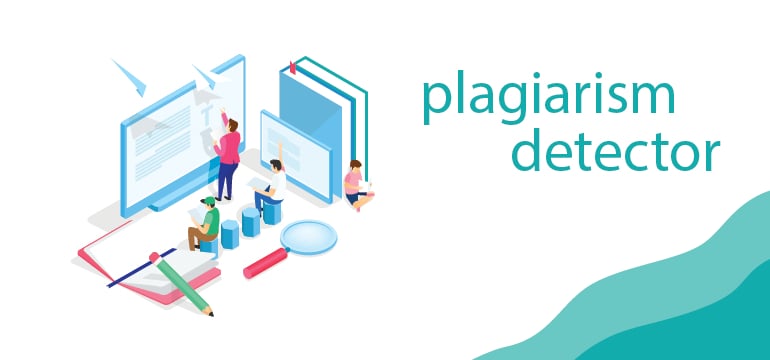PlagiarismDetector.net Vs Duplicheker.com
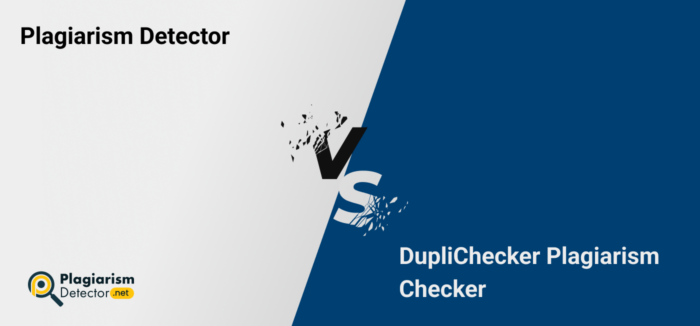
Plagiarism detection tools are becoming a necessity in today’s world. Copying someone else’s work is not only unethical; it is also a serious offense. It is also increasingly easy to detect, even with basic software. However, it is becoming increasingly difficult to flag it sentence by sentence, as plagiarists adopt more sophisticated tactics to disguise copied content. That’s why there is a growing need for advanced tools that can keep up.
In this blog, we will be comparing two of the finest duplication checker tools for a comprehensive analysis. We will see how they perform in terms of accuracy, features, and overall user experience. However, first, let’s provide a brief introduction to both tools.
Intro to PlagiarismDetector.net
PlagiarismDetector is a specialized plagiarism-checking tool designed to meet the needs of academics, professionals, and publishers. It goes beyond basic scanning by offering deep content analysis and identifying exact matches. The tool is particularly useful for students, educators, and researchers who require a reliable method to maintain originality in their work. Its advanced features make it a strong choice for those seeking a comprehensive solution.
Intro to DupliChecker.com
DupliChecker is a versatile and user-friendly platform that offers a wide range of writing and editing tools. However, plagiarism detection is one of its most used tools. It allows users to detect duplicate content instantly across billions of online sources. Its simple interface, free accessibility, and multi-tool environment make it ideal for users looking for efficient support in producing original content.
PlagiarismDetector.net vs. DupliChecker.com
From the introduction, it is clear that both tools are competitive. But we will get to the minor details to bring out the most effective one. So, let’s get started.
Accuracy
Accuracy is the most important feature of any plagiarism checker. Therefore, we will first check the credibility of these tools in detecting duplicated text. For this purpose, we have conducted a total of three tests. In each test, we will deliberately add a certain amount of plagiarism to reveal the reliability of the results.
Complete Plagiarism Test
For this test, we have directly copied and pasted an entire section from a blog on Stanford Lifestyle Medicine’s site into both tools. Here are the results.
PlagiarismDetector.net
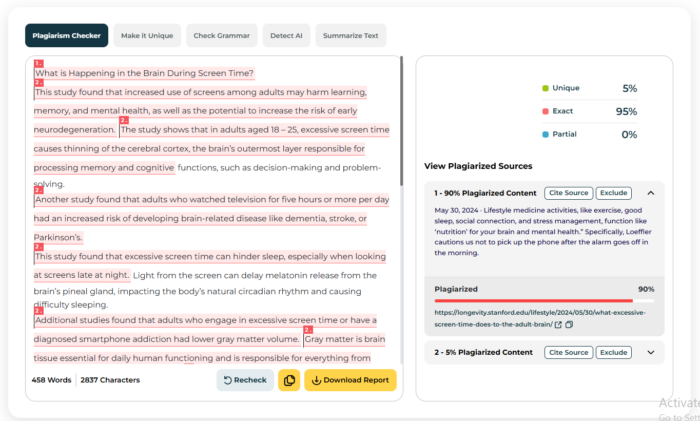
DupliChecker.com
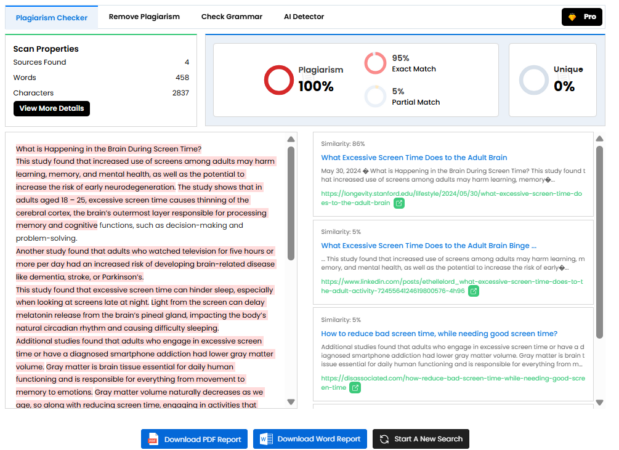
Comparison:
From the results, it is clear that both tools have accurately flagged the content as copied. So, both are winners here. Also, we would like you to notice a minor detail here. Both tools have shown results as exact and partial plagiarism for a detailed breakdown.
Partially Plagiarized
Now, we will use the same content, but with a slight variation of unique content. So, basically, we will be using half duplicated and half unique content.
PlagiarismDetector.net
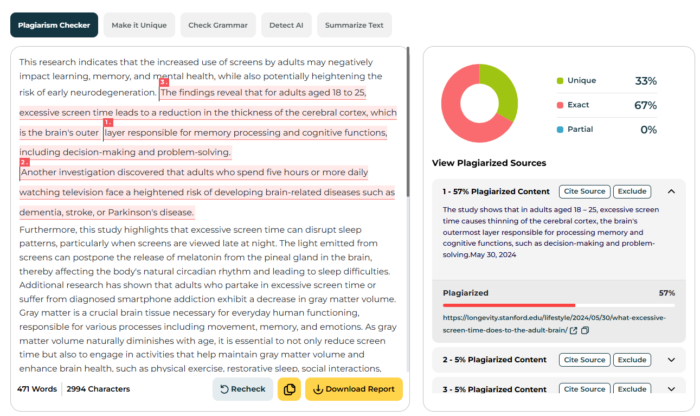
DupliChecker.com
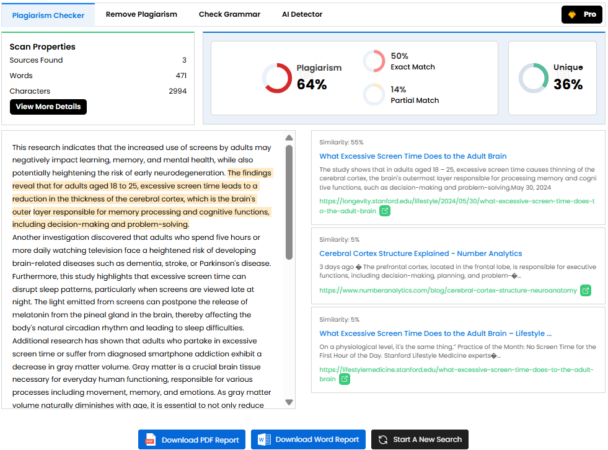
Comparison:
Here, the results clearly show that the content is accurately flagged. Both tools show the same results. Also, the PlagiarismDetector is showing color-coded highlights to distinguish between partial and exact plagiarism.
Unique Content
Now, we will add originally written content in the tools to check for their reliability.
PlagiarismDetector.net
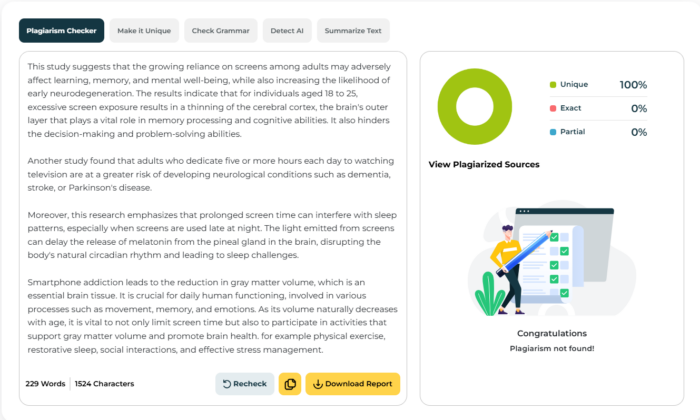
DupliChecker.com
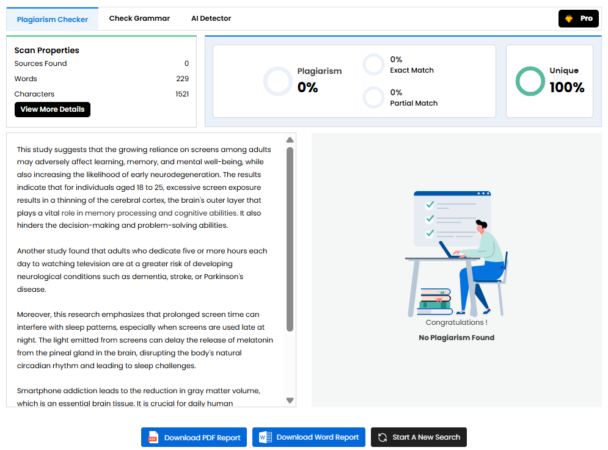
Comparison:
As you can observe, both tools have shown accurate results. We added unique data into both utilities, and they have returned authentic output. Therefore, they are reliable in all sorts of plagiarism.
Features
When comparing these tools, it is clear that both tools are designed to support writers and researchers. However, each tool has its own strengths, depending on how deep or quick you want your plagiarism check to be. Here is a closer look at the key features:
Database and Content Comparison
Both tools compare your content against billions of web pages, journals, research papers, and online documents. But there is a bit of a difference.
The first one stands out for its academic depth. It scans through educational databases, scholarly articles, and subscription-based sources to catch less obvious matches. On the other hand, DupliChecker.com offers excellent web-wide scanning. So, it is best for online publishers, bloggers, and general writers looking for surface-level matches.
Similarity Reports
Once the scan is complete, both tools generate visual reports that show the percentage of unique and duplicated content.
PlagiarismDetector.net provides an in-depth report with matching phrases linked directly to their original sources. The report includes a breakdown by match strength and segment location. The other one offers a cleaner, faster summary, perfect for a quick review. Although it is not as detailed, it is easy to navigate and understand.
Exact Match Detection
Both tools are efficient in identifying word-to-word copying. They highlight copied phrases and sentences, which makes it easy for users to locate and revise the content. However, the plagiarism detector uses color-coded highlights tied to individual sources. This makes it easier to handle each section one by one.
Paraphrased Plagiarism Detection
Catching paraphrased content is much harder as it is a sneaky way to copy content. But both tools have features to help here.
Two of these tools use AI-based pattern recognition and context analysis to spot when sentences have been reworded but carry the same meaning. More sophisticated rewrites or academic-level restatements could not be caught as the content is highly altered.
Source Identification
Identifying the origin of the copied content is essential for correcting or citing properly. So, these tools are equipped to fetch the source.
The duplication checker by PlagiarismDetector.net links each match to the exact source. The user finds out whether the main content is a blog post, a research paper, or a published book chapter. The same applies to DupliChecker.com. It also provides source URLs and page titles with the primary sources.
Integration with Word Processors
For user convenience, it is important to have originality checkers that support uploading documents. Both tools allow users to upload .docx, .txt, or .pdf files for scanning, which is convenient for writers working in MS Word or Google Docs.
PlagiarismDetector.net offers smoother compatibility with file formats and features a copy-paste box that retains formatting. Meanwhile, DupliChecker.com focuses on ease and speed, so it also offers quick uploads.
Customizable Settings
The first tool lets users fine-tune their scans. You can exclude specific URLs, set sensitivity levels, or ignore quoted content and references. The other one also offers many customization options, which are helpful for a high-level duplication check.
AI-Powered Analysis
AI plays a strong role in content checking today. The tools we choose to compare have strong support from artificial intelligence. Both use natural language processing to understand the intent of sentences and detect more nuanced duplication. They also have the ability to focus on keyword and phrase matching while doing a full semantic analysis.
DupliChecker doesn’t offer this smart feature yet, putting PlagiarismDetector a step ahead.
Citing Resources on the Spot
One of the standout features of PlagiarismDetector is its built-in citation tool. If any part of your content is flagged as copied, you can instantly add a proper citation with just one click, saving time and maintaining academic integrity.
Exclude Resource
Another feature where the plagiarism detector takes the win is this unique feature. After the duplication check is completed, the tool shows the resources from which the content was copied. Along with the link, it shows an “Exclude Resource” button. By clicking on it, the tool will ignore that site and show the result.
DupliChecker has not added this advanced feature for now. But we hope for an update soon.
Reports and Feedback
Both tools offer detailed, downloadable, and printable reports.
PlagiarismDetector.net delivers a detailed PDF report that breaks down every match with source links, match percentages, and clear visual formatting. The other tool provides reports in a similar format, available in both PDF and Word. They are simpler, web-based reports that are easy to print or share with a depth found in academic-focused tools.
Integrated Tools
PlagiarismDetector.net includes a built-in AI grammar mistakes detector to support the proofreading process. It can identify the potential mistakes and provide suggestions to rectify them. It is also helpful to correct any errors that were left during the editing process. The same goes for DupliChecker.com. It also has an integrated grammar checker to assist with the editing process.
Pricing
PlagiarismDetector.net
First, it has a free version that allows up to 1000 words per session. It also has three separate pricing plans for users. Bulk checking and deep scanning are also included. Other than that, they have monthly and yearly plans starting from $8 per month.
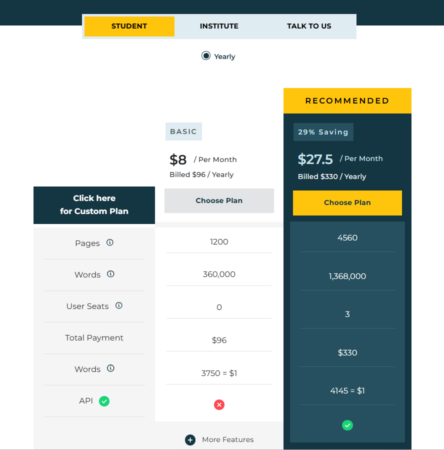
The tool also offers custom packages for academic institutions, publishers, or professionals with high-volume requirements. These plans provide greater flexibility and more control over the number of scans and features used.
To view exact prices or request a custom quote, visit their official pricing page.
DupliChecker.com
DupliChecker.com is known for its free access to several writing tools, including its basic plagiarism checker. However, the free version has limited word count of 1000. It is also a bit expensive than the previous one as its weekly subscription starts from $5.
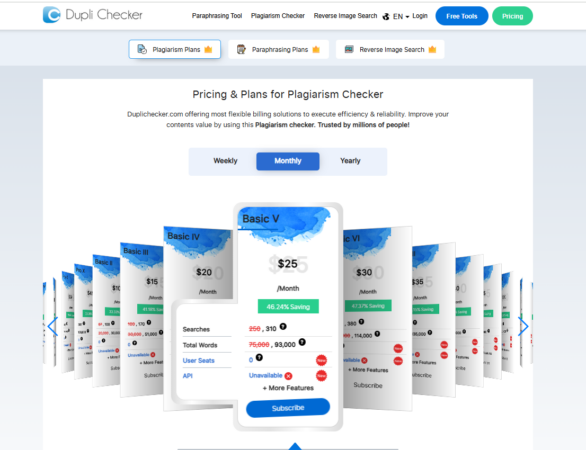
For more robust plagiarism scanning and access to additional features like advanced reports and higher word limits, DupliChecker offers premium subscriptions. These are monthly or annual plans designed for regular users like students, bloggers, and content creators.
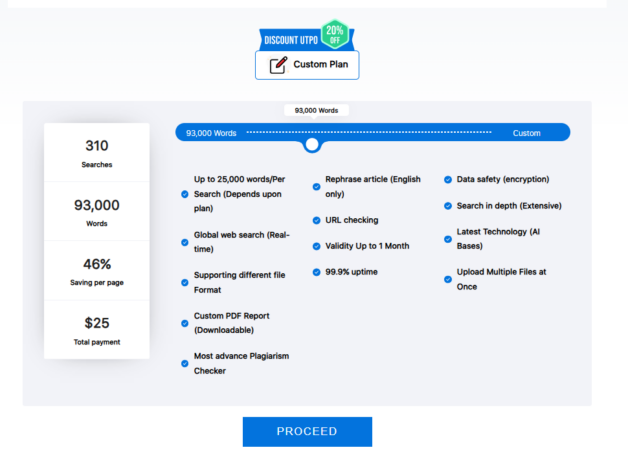
You can view all available pricing options and plan details directly on the DupliChecker premium plans page.
Which One Offers Better Value?
Both tools cater to different user needs. If you are looking for a feature-rich experience with extensive customization, PlagiarismDetector.net might be more suitable. If affordability and quick scanning are your main concerns, DupliChecker.com is a solid option. The best choice depends on your usage frequency, document size, and the level of detail you require from the plagiarism reports.
Quick Overview
Here’s a side-by-side comparison to help you review both tools at a glance:
Wrap Up
With this complete comparison, we have come to the conclusion that both PlagiarismDetecor.net and DupliChecker.com are highly accurate. There is just a minor difference in some of their features. However, the work and the results are almost the same. You can get any of these without having to think about their performance. We can say that these tools could be the best addition to your proofreading process.

